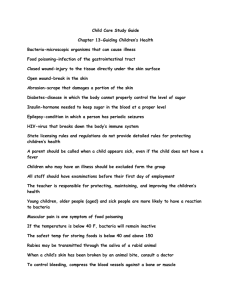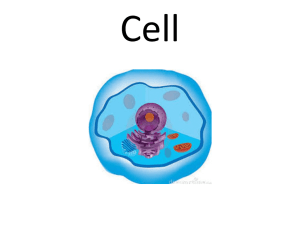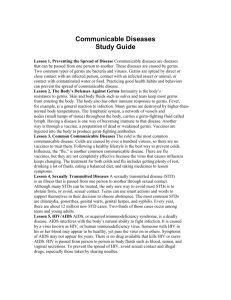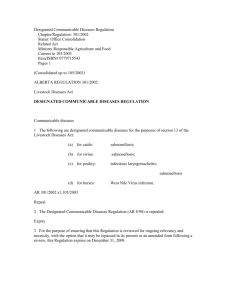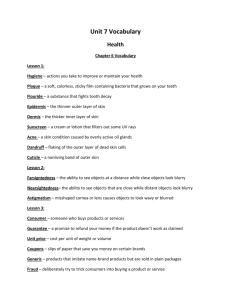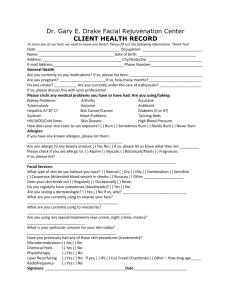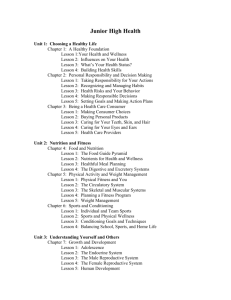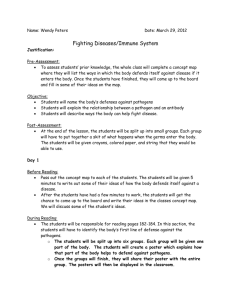disease - Parkway C-2
advertisement
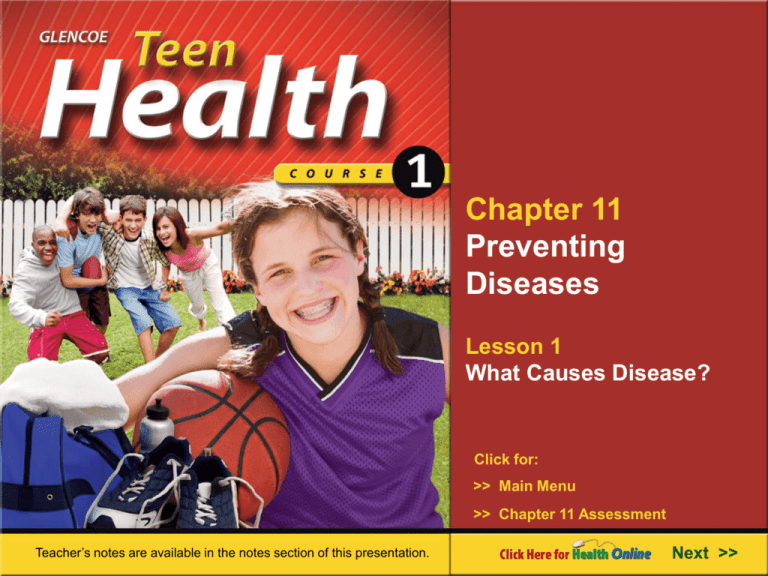
Chapter 11 Preventing Diseases Lesson 1 What Causes Disease? Click for: >> Main Menu >> Chapter 11 Assessment Teacher’s notes are available in the notes section of this presentation. Next >> Essential Question: Why is it important to remain germ free? Enduring Understanding: Students will understand that pathogens are spread through direct contact, indirect contact, through impure food or unclean water, and contact with animals or insects. protozoa Noncommunicable diseases fungi Single-celled organisms that have a nucleus Diseases that do not spread Primitive single- or many-celled organisms that cannot make their own food In this lesson, you will learn to identify the two main types of disease. recognize four common disease-causing organisms. describe how germs spread. Analyzing a Graphic Create a concept map that shows how germs can be spread. Use this diagram as a guide. Germs What Is a Disease? The science of fighting disease has come along way in the past hundred years. disease A condition that affects the proper functioning of the body or mind Types of Diseases The two basic categories of diseases are: Communicable diseases Noncommunicable disease communicable diseases Diseases that can be spread noncommunicable diseases Diseases that do not spread Germs that Cause Disease Pathogen is the scientific name for germ. pathogen A microscopic organism that causes communicable diseases Four Classes of Pathogens Viruses Bacteria Protozoa Fungi Germs that Cause Disease Some viruses are harmless and some cause diseases. viruses Tiny, nonliving particles that invade and take over healthy cells The common cold, the flu, the measles, and AIDS are examples of diseases caused by viruses. Germs that Cause Disease Bacteria is everywhere. bacteria Extremely small single-celled organisms with no cell nucleus Strep throat, Lyme disease, and tooth decay are examples of disease caused by bacteria. Germs that Cause Disease Protozoa can be harmless, but some strains can cause serious disease. protozoa Single-celled organisms that have a nucleus Malaria is an example of a disease caused by protozoa. Germs that Cause Disease Fungi survive by breaking down other living organisms and absorbing their nutrients. fungi Primitive single- or many-celled organisms that cannot make their own food Some strains of fungi, such as molds and yeasts cause disease. How Germs Are Spread Direct Contact (shaking hands) Eating or Drinking Contaminated Food or Water Germ Indirect Contact (sneezing) Contact with Animals or Insects Lesson 1 Review What I Learned Vocabulary Define pathogen. Use the word in a sentence. Lesson 1 Review What I Learned Recall Name a disease caused by a fungus. Lesson 1 Review What I Learned Identify Name four common disease-causing organisms. Lesson 1 Review Thinking Critically Explain What is the difference between a communicable disease and a noncommunicable disease? Lesson 1 Review Thinking Critically Apply Should you take a bite of a friend’s sandwich if you had seen him or her coughing and sneezing earlier in class? Chapter 11 Preventing Diseases Lesson 2 Communicable Diseases Click for: >> Main Menu >> Chapter 11 Assessment Teacher’s notes are available in the notes section of this presentation. Next >> Activity: MOVE YOUR BODY. 1. Why is it important to remain germ-free? Provide examples (3) to support your answer. 2. Provide (2) examples for communicable and (2) examples for noncommunicable disease. 3. How germs can be spread? Essential Question: How can I protect myself from disease? Enduring Understanding: Communicable diseases can be prevented with good hygiene practices and vaccines. contagious Spreading a virus to others by direct or indirect contact A group of cells, tissues, and organs that fight immune system disease Strep throat Hepatitis It is a bacterial throat infection that can make your throat feel sore and scratchy. Inflammation of the liver, caused by a virus or a toxin and characterized by jaundice, liver enlargement, and fever. In this lesson, you will learn to recognize ways pathogens are spread. identify common communicable diseases. demonstrate healthful behaviors that limit the spread of pathogens. Common Communicable Diseases When symptoms of a cold first appear, you are contagious. contagious Spreading a virus to others by direct or indirect contact The cold is the most common communicable disease. Common Communicable Diseases Symptoms of influenza, or “the flu,” include high fever and joint and muscle aches. Common Communicable Diseases Disease Symptoms Treatment Mononucleosis Swollen lymph glands (in neck, underarms, groin), headaches, sore muscles, sore throat, fever, fatigue Pain relievers, rest, liquids Hepatitis A, B, and C Weakness, fatigue, nausea, vomiting, fever, yellowing of eyes, abdominal pain, dark urine Rest, healthful food choices (medication for Types B and C) Tuberculosis (TB) Cough, fatigue, persistent fever, night sweats, weight loss Antibiotics taken over a long period of time Strep throat Sore throat, fever, chills, body aches, loss of appetite, nausea, vomiting, swollen tonsils or glands Antibiotics, soft foods, liquids, gargling with salt water Keep it to Yourself When you have a cold, take action to prevent spreading your cold to others. Be careful to cover your mouth and nose when you cough or sneeze. Avoid sharing cups, utensils, or other personal items. Your Body’s Defenses In a typical day, your body is exposed to millions of germs. You aren’t sick all the time because your body is protected by its own defense system. Keeping Pathogens Out The Body’s Five Major Barriers to Block Pathogens Tears Saliva Mucous Membranes Skin Stomach Acid Your Body’s First Line of Defense Skin Body Fluids Mucous Membranes Pyrogen Pyrogen Skin Body Mucous Fluids Membranes • A Your Tears Tissues chemical skin and that issaliva that like linecauses athe act wall as inside around a barrier. raise of your your in blood mouth, innertemperature organs. throat, nose soand that eyes act germs have as barriers. a hard time surviving. • Fights These infection. are sticky fluids that trap and destroy germs. infection The result of pathogens or germs invading the body, multiplying, and harming some of your body’s cells Your Immune System Your immune system is your second line of defense. immune system A group of cells, tissues, and organs that fight disease Your Immune System Some lymphocytes attack pathogens directly while others produce antibodies. lymphocyte A white blood cell that attacks pathogens or harmful germs antibodies Chemicals produced specifically to fight a particular invading substance Your Immune System Antibodies recognize germs that reenter the body and will attack and destroy them. This is called immunity. immunity Resistance to infection Preventing Communicable Diseases Steer clear of people who you know are sick. Get in the habit of washing your hands regularly. Get enough rest, eat healthy foods, and exercise. Preventing Communicable Diseases A vaccine triggers the immune system to make antibodies to fight the pathogen. vaccine A dead or weakened pathogen introduced into your body Preventing Communicable Diseases Vaccine The Disease It Protects Against Hep B Hepatitis B DTaP Diphtheria, tetanus, pertussis (whooping cough) Hib Disease caused by Hemophilus influenza type B (Hib) bacteria IPV Poliomyelitis PVC Diseases caused by Streptococcus pneumoniae bacteria MMR Measles, mumps, rubella Varicella Chicken pox Hep A Hepatitis A Lesson 2 Review What I Learned Describe What is the most common communicable disease? Name some other common communicable diseases. Lesson 2 Review What I Learned Vocabulary Define antibodies, and use it in a sentence. Lesson 2 Review What I Learned List Name a disease that can be prevented with a vaccine. Lesson 2 Review Thinking Critically Apply Why should you avoid sharing an ice cream cone with a friend who has a cold? Lesson 2 Review Thinking Critically Analyze How does handwashing help protect the health of your school and community? Chapter 11 Preventing Diseases Lesson 4 Noncommunicable and Hereditary Diseases Click for: >> Main Menu >> Chapter 11 Assessment Teacher’s notes are available in the notes section of this presentation. Next >> Essential Question: How can I protect myself from disease? Enduring Understanding: students will understand that to avoid diseases like cancer and diabetes, you should avoid tobacco, protect yourself from the sun’s UV rays and maintain an active, healthful lifestyle. DO NOW 1. What different ways can pathogens be spread? 2. What is the most common communicable disease? 3. Identify at least three different barriers (line of defense) that your body uses to block pathogens. chronic Long-lasting cancer A disease caused by abnormal cells that grow out of control allergy The body’s sensitivity to certain substances Heart disease Heart disease is a range of diseases that affect your heart. In this lesson, you will learn to identify causes of various noncommunicable diseases. develop behaviors to keep your heart healthy. identify ways to help prevent diseases like cancer and diabetes. What Causes Noncommunicable Diseases? Poor Health Habits A Person’s Environment Effects of a Communicable Disease Heredity Present at Birth Heart Disease Heart disease is the number one cause of death in the United States and is an example of a chronic disease. chronic Long-lasting Common causes of heart disease include the narrowing or blocking of blood vessels and high blood pressure. Healthy Habits for your Heart Stay Physically Active Maintain a Healthy Weight Learn to Manage Stress Eat Foods High in Fiber and Low in Salt, Fat, and Cholesterol Don’t Use Tobacco Products Treating Heart Disease There are medications that widen blood vessels, lower blood pressure, and control the heartbeat. For more serious problems, heart disease is treated with surgery. Cancer Cancer starts out as a tumor. cancer A disease caused by abnormal cells that grow out of control tumor A mass of abnormal cells Cancer is the second leading cause of death in the United States. Cancer Some tumors are noncancerous, or benign. Tumors that are cancerous are call malignant. Cancer Causes of Cancer Heredity Exposure to Cancer-Causing Substances Poor Health Choices Smoking accounts for at least 30% of all cancer deaths. Cancer Avoiding Cancer Eat Well Stay Active Use Sunscreen Don’t use tobacco or drugs Treating Cancer Seven Cancer Warning Signs C Changes in bowel or bladder habits A A sore that does not heal U Unusual bleeding or discharge T Thickening or lump in breast or elsewhere I Indigestion or difficulty swallowing O Obvious changes in a wart or mole N Nagging cough or hoarseness Treating Cancer Ways of Treating Cancer Surgery Radiation Before the cancer has spread Chemotherapy Biologic Therapies After the cancer has spread Allergies If you sneeze when you are around cats, you may have an allergy. allergy The body’s sensitivity to certain substances A substance that causes an allergic reaction is called an allergen. Asthma Asthma is a health problem related to allergies. asthma A chronic disease in which the airways become irritated and swollen During an asthma attack, the small airways of the lungs become coated with a thick mucous. Asthma Asthma Triggers Allergens Physical Activity Cold or Damp Air Cigarette Smoke and Other Sources of Air Pollution Diabetes Diabetes is caused when the body doesn’t produce enough insulin. diabetes A disease that prevents the body from using the sugars and starches in food for energy insulin A hormone produced by the pancreas Diabetes Types of Diabetes Type 1 Diabetes Type 2 Diabetes Symptoms of Diabetes Increased thirst Frequent urine production The body does not produce insulin at all. The body makes insulin but is unable to use it efficiently. Lack of energy Blurred vision Diabetes Percentage of Obese Children and Teens Over a 40-year Time Period Diabetes in Young People The increase in obesity is related to the increase in type 2 diabetes in young people. Type 2 diabetes used to occur mainly in adults. Treatment of Diabetes Treatments for diabetes include: Monitoring blood sugar levels Taking insulin Exercising regularly Watching weight Developing a good meal plan Lesson 4 Review What I Learned Vocabulary What is chronic disease? Lesson 4 Review What I Learned Identify Name a noncommunicable disease triggered by an allergen. Lesson 4 Review What I Learned Describe What are some ways of preventing cancer? Lesson 4 Review Thinking Critically Synthesize Name some ways to keep your heart healthy and lessen the risks of heart disease. Lesson 4 Review Thinking Critically Compare How are allergies and asthma similar? How are they different? Chapter 12 Safety and the Environment Lesson 1 Personal Safety Habits Click for: >> Main Menu >> Chapter 12 Assessment Teacher’s notes are available in the notes section of this presentation. Next >> accidents Unexpected events that result in damage or harm accidental injuries Injuries caused by unexpected events accident chain A sequence of events that often leads to an accidental injury In this lesson, you will learn to identify the parts of the accident chain. describe ways of preventing accidental injuries. practice healthful behaviors to develop good safety habits. Identifying Cause-and-Effect List three events that can result in accidental injury. 1. 2. 3. Staying Safe Learning about safety can help prevent accidents and accidental injuries. accidents Unexpected events that result in damage or harm accidental injuries Injuries caused by unexpected events The Accident Chain Accidents often occur because of an accident chain. accident chain A sequence of events that often leads to an accidental injury The Situation The Unsafe Habit The Unsafe Act How to Prevent Accidental Injuries By removing or changing any one link in the accident chain, you can top an accident from happening. Lesson 1 Review What I Learned Vocabulary What are accidental injuries? Lesson 1 Review What I Learned List What three elements must be present for an accident to occur? Lesson 1 Review What I Learned Recall How can many accidents be prevented? Lesson 1 Review Thinking Critically Apply Grant’s friend dared him to walk across a narrow 12-foot high fence. What should Grant do, and why? Lesson 1 Review Thinking Critically Evaluate Why is it important to know your limitations? Chapter 12 Safety and the Environment Lesson 2 Safety at Home and Away Click for: >> Main Menu >> Chapter 12 Assessment Teacher’s notes are available in the notes section of this presentation. Next >> Essential Question: Are most injuries and accidents preventable? Enduring Understanding: Students will understand that there are many safety hazards in the home. hazard Possible sources of harm smoke alarm A device that makes a warning noise when it senses smoke In this lesson, you will learn to explain how to prevent accidental injuries in you home. practice the skill of advocacy to help family members develop a fire escape plan. identify safety tips and rules of the road. describe how to be safe in your school and community. Safety at Home Following safety rules will reduce the risks of home hazards. hazards Possible sources of harm Safety at Home Learn to handle knives correctly Wipe up spills right away Don’t leave food cooking unattended Kitchen Safety Keep children away from the stove Turn pot handles inward Safety at Home Keep stairways well lighted and free of clutter Rugs should be fastened down firmly Preventing Falls Never run on wet or waxed floors Never stand on a chair Use a sturdy ladder or step stool Safety at Home Pull plugs out by the plug, not the cord Never use appliances when your hands are wet Don’t use an appliance with a frayed cord Electrical Safety Keep appliances away from water Unused outlets should be covered when children are present Safety at Home Guns should be stored in locked cabinets Store ammunition away from guns Gun Safety Never handle a gun without an adult present Never point a gun at a live target Safety at Home Make sure matches are out before disposing of them Keep a fire extinguisher in the house Never leave candles burning unattended Fire Safety Keep lighters away from children Use a smoke alarm smoke alarm A device that makes a warning noise when it senses smoke fire extinguisher A device that releases chemicals that smother flames Safety and Personal Responsibility Pick up an object you see lying on the floor where someone might trip over it. This can prevent someone you care about from being injured. Safety on the Road Safety on the road applies to drivers, passengers, and pedestrians. pedestrians People traveling on foot Safety on the Road Rules of the Road Obey traffic rules. Ride your bike with the traffic flow, and obey traffic signals. Never weave in and out of traffic. When riding with a friend, ride in single file. When riding, check for cars before entering traffic. Watch for pedestrians. Be visible to others. Wear bright clothes and use a light after dark. Safety on the Road Tips for Personal Safety Use your safety belt when riding in a motor vehicle. Use safety equipment when riding a bike, skating, or riding a scooter. Don’t skate or ride a scooter after dark. Avoid riding or skating on wet, dirty, or uneven surfaces. Wear flat-soles shoes for riding a scooter. Wear pants that won’t catch in a bicycle chain. Keep your speed under control. Safety at School Never carry a weapon and alert school officials if you know, or suspect, someone has a weapon. Safety in the Community Many communities have formed Neighborhood Watch Programs. Neighborhood Watch Programs Programs in which residents are trained to identify and report suspicious activity Safety in the Community You can protect yourself by: Walking with purpose to and from your home Traveling with another person or in a group Avoiding talking to strangers Avoiding shortcuts through unfamiliar or unsafe areas Lesson 2 Review What I Learned Recall Where should smoke alarms be placed in the home? Lesson 2 Review What I Learned Describe What are two ways of making yourself safe when riding your bike? Lesson 2 Review What I Learned Vocabulary What is a Neighborhood Watch Program? Lesson 2 Review Thinking Critically Explain In what ways is a cluttered room a hazard? Lesson 2 Review Thinking Critically Analyze Why do you think there is debate on whether metal detectors should be in school? End of Chapter 12 Safety and the Environment Lesson 2 Safety at Home and Away Click for: >> Main Menu >> Chapter 12 Assessment Chapter 12 Safety and the Environment Lesson 3 Safety Outdoors Click for: >> Main Menu >> Chapter 12 Assessment Teacher’s notes are available in the notes section of this presentation. Next >> hypothermia A sudden and dangerous drop in body temperature In this lesson, you will learn to describe what you need to know for water safety. explain safety when hiking or camping. practice decision-making skills to make safe choices. Finding the Main Idea For each main heading in this lesson, write one sentence that states the main idea. Main Headings in this Lesson: • Staying Safe Outdoors • Water Safety • Safety on the Trail Staying Safe Outdoors Take these steps before planning any outing. Check the weather forecast. Make sure you have the proper safety gear. Be aware of your skills and abilities. Wear sunscreen Wear bug protection. Water Safety Know how to swim well. Follow the safety rules. Never swim alone. Use the “buddy system.” Go to beaches or pools that have lifeguards. Know the water depth. Water Safety When boating or waterskiing, wear a life jacket at all times. If you ever feel in danger of drowning, stay calm and call for help Wear a wetsuit to prevent hypothermia. hypothermia A sudden and dangerous drop in body temperature Water Safety Drowning Prevention Water Safety Drowning Prevention Water Safety Drowning Prevention Water Safety Drowning Prevention Water Safety Drowning Prevention Water Safety Drowning Prevention Safety on the Trail For hiking, wear sturdy, well-cushioned shoes. Wearing two pairs of socks will prevent blisters. Bring enough food and water. Bring clothing that is appropriate for the season. Make sure someone knows where your are going. Bring items such as flashlights, batteries, and walkie talkies. Lesson 3 Review What I Learned Recall What is the buddy system? Why is it important? Lesson 3 Review What I Learned Vocabulary What is hypothermia? Lesson 3 Review What I Learned List Name two ways of staying safe during water activities. Lesson 3 Review Thinking Critically Apply Larissa is going for a short hike by herself. What safety precautions should she take before she leaves? Lesson 3 Review Thinking Critically Analyze Suppose you are swimming in the ocean when you realize you have gone farther that you should. You don’t feel you have enough energy left to swim back. What should you do? End of Chapter 12 Safety and the Environment Lesson 3 Safety Outdoors Click for: >> Main Menu >> Chapter 12 Assessment Chapter 12 Safety and the Environment Lesson 4 Safety in Severe Weather Click for: >> Main Menu >> Chapter 12 Assessment Teacher’s notes are available in the notes section of this presentation. Next >> natural disasters Events caused by nature that result in widespread damage destruction, and loss hurricane A strong tropical windstorm with driving rain frostbite Freezing of the skin tornado A whirling, funnel-shaped windstorm that drops from the sky to the ground earthquake The shaking of the ground as rock below the surface moves In this lesson, you will learn to identify types of weather emergencies and natural disasters. recognize how to prepare for weather emergencies and natural disasters. Compare and Contrast As you read, keep notes on the differences between weather emergencies and natural disasters. Weather Emergencies and Natural Disasters Having an emergency kit is part of preparing for natural disasters. natural disasters Events caused by nature that result in widespread damage, destruction, and loss Thunderstorms Lightning is the most dangerous part of a thunderstorm. Lightning is caused by clouds releasing stored-up electrical energy. Thunderstorms Thunderstorm Tips Seek shelter. Do not use the telephone. If you are in a large field with no shelter, lie down. Avoid all metal objects. Stay away from trees, electric wires, canopies. Stay away from water. Hurricanes A hurricane can cause high waves, which in turn can produce flooding. hurricane A strong tropical windstorm with driving rain Wind speeds during a hurricane can reach or exceed 100 miles per hour. Hurricanes Hurricane Tips Board windows. Bring in outdoor objects. Monitor TV and radio reports closely. Obey orders to leave the area if instructed. Tornadoes A tornado is most likely to occur in the flat central regions of the country. tornado A whirling, funnel-shaped windstorm that drops from the sky to the ground Floods The most common natural disasters are floods. Flooding is especially serious in regions near large bodies of water. Floods Flood Tips Never walk or ride in a car through floodwater. Watch out for downed power lines. Only drink bottled water. Clean and disinfect everything that touched floodwater. Throw out all contaminated food. Make sure the water supply is safe before drinking. Blizzards A blizzard can shut down roads and make it hard for food and other daily needs to reach consumers. A whiteout is a state where snow falls so rapidly, visibility is significantly reduced. Blizzards Health risks from being in a blizzard include: Hypothermia Frostbite frostbite Freezing of the skin Frostbite can cause severe injury to the skin and sometimes to deeper tissue. Tornadoes A tornado is most likely to occur in the flat central regions of the country. tornado A whirling, funnel-shaped windstorm that drops from the sky to the ground Tornadoes Tornado Tips Go to a storm cellar. If you don’t have a storm cellar, go to a hallway, bathroom, or other room with no windows. Don’t stay in a car or mobile home. If you are outdoors, look for a ditch and lie down. Earthquakes If you are inside when an earthquake hits, stay there. earthquake A The shaking of the ground as rock below the surface moves Earthquakes Earthquake Tips Brace yourself in a doorway. If possible, crawl under a large piece of furniture. Move away from objects that could fall. If you are outside, stand in the open and stay away from trees, buildings, and power lines. After an earthquake, report any odor of gas. Lesson 4 Review What I Learned Compare What is the difference between a weather emergency and natural disaster? Lesson 4 Review What I Learned Vocabulary What is a hurricane? Where do hurricanes occur? Lesson 4 Review What I Learned Identify Which type of weather emergency can lead to whiteout conditions? Lesson 4 Review Thinking Critically Evaluate How does the media influence community health during a natural disaster or weather emergency? Lesson 4 Review Thinking Critically Analyze Suppose you are swimming when the sky turns dark. You hear a distant rumble. What should you do to take responsibility for your personal health? End of Chapter 12 Safety and the Environment Lesson 4 Safety in Severe Weather Click for: >> Main Menu >> Chapter 12 Assessment Chapter 12 Safety and the Environment Lesson 5 First Aid for Emergencies Click for: >> Main Menu >> Chapter 12 Assessment Teacher’s notes are available in the notes section of this presentation. Next >> Dislocation: displacement of one or more bones at a joint Fracture: it is the breaking or cracking of a bone or the tearing of a cartilage. first aid The care first given to an injured or ill person until regular medical care can be supplied rescue breathing A substitute for normal breathing in which someone forces air into the victim’s lungs cardiopulmonary A rescue measure that attempts to restore resuscitation (CPR heartbeat and breathing abdominal thrust Pulled muscle: when a muscle becomes overstretched and tears. Quick upward pulls into the diaphragm to force out the object blocking the airway Cramp: A sudden, involuntary, spasmodic muscular contraction causing severe pain, often occurring in the leg or shoulder as the result of strain or chill. poison control center A community agency that helps people deal with poisoning emergencies first-degree burn A burn in which only the outer part of the skin in burned and turns red second-degree burn A burn in which the damaged area blisters or peels third-degree burn A very serious burn in which deeper layers of skin and nerve endings are damaged In this lesson, you will learn to name strategies for responding to emergencies. describe how you can help someone who is bleeding. identify the universal sign for choking. explain how to help a burn victim. Sequencing Choose two of the emergencies described in the lesson. For each, make a flow chart showing the steps in treating the emergency. Giving First Aid Giving first-aid can mean the difference between life and death. first aid The care first given to an injured or ill person until regular medical care can be supplied Giving First Aid Check Call Care Life Threatening Emergencies A victim’s life is in danger if the person: has stopped breathing has no heartbeat is bleeding severely is choking has swallowed poison has been severely burned Rescue Breathing and CPR If the victim is not breathing, perform rescue breathing. rescue breathing A substitute for normal breathing in which someone forces air into the victims lungs Rescue Breathing and CPR Rescue Breathing and CPR A life-saving technique for victims whose hearts have stopped beating is cardiopulmonary resuscitation (CPR). cardiopulmonary resuscitation (CPR) A rescue measure that attempts to restore heartbeat and breathing First Aid for Severe Bleeding When treating a victim with severe bleeding, take precautions to limit touching another person’s blood. Wear gloves if possible and always wash your hands afterward. First Aid for Severe Bleeding Tips for treating a victim with sever bleeding include: Lie the person down. Elevate the wounded body part above the victim’s heart if there are no broken bones. Apply direct, steady pressure to the wound with a clean cloth. Do not press too hard. Once the bleeding has stopped, cover the wound with a clean cloth. Get medical help immediately. First Aid for Choking Choking is a condition that occurs when a person’s airway becomes blocked. A chocking victim can die in minutes because air cannot get to the lungs. First Aid for Choking If you know someone is choking, begin using abdominal thrusts. abdominal thrusts Quick upward pulls into the diaphragm to force out the object blocking the airway First Aid for Poisoning If you think someone has swallowed poison, call 911, EMS, or your local poison control center. poison control center A community agency that helps people deal with poisoning emergencies The inside cover of your phone book should list the phone number of the poison control center. First Aid for Poisoning Take these steps while waiting for help to arrive. Keep the person warm and breathing. Remove extra traces of poison from the person’s mouth with a damp, clean cloth. Save the container of the poison to show the ambulance team. Prepare to tell the emergency team all you know about what happened. First Aid for Burns Treatment for a first-degree burn includes: Cooling the burned area with cold water (not ice) for at least 15 minutes Wrapping the burned area loosely in a clean, dry dressing first-degree burn A burn in which only the outer part of the skin is burned and turns red First Aid for Burns Treatment for a second-degree burn includes: Cooling the burned area with cold water (not ice) Elevating the burned area Wrapping the burned area loosely in a clean, dry dressing Seeing a doctor second-degree burn A serious type of burn in which the damaged area blisters or peels First Aid for Burns Treatment for a third-degree burn includes: Cooling the burn with cold water or by applying a wet cloth Not applying ice or ointments Removing clothing that may stick to the burned area while applying cold water Wrapping the burned area loosely with a clean, dry dressing and call 911 third-degree burn A very serious burn in which deeper layers of skin and nerve endings are damaged First Aid for Breaks and Sprains Take these steps when helping someone who fractured a bone. Ask if the person heard a snap or if touching the injured area hurts. If unsure, treat the person as if they have a broken bone and call 911. If there is bleeding, apply pressure with a clean cloth. Do not attempt to straighten out the injured part. Avoid moving the person. First Aid for Breaks and Sprains A sprain occurs when a joint is stretched or twisted or has torn ligaments. Sprains are often sports-related. Lesson 5 Review What I Learned Recall What is the universal sign for choking? Lesson 5 Review What I Learned List Briefly give the steps in controlling severe bleeding. Lesson 5 Review What I Learned Vocabulary What’s the difference between a first- and second-degree burn? Lesson 5 Review Thinking Critically Evaluate What steps can be taken to reduce poisoning risks in homes with small children? Lesson 5 Review Thinking Critically Apply Ken and Phil see and older student collapse to the ground. Using the CHECK-CALL-CARE strategy, show how Ken and Phil should respond to this emergency. End of Chapter 12 Safety and the Environment Lesson 5 First Aid for Emergencies Click for: >> Main Menu >> Chapter 12 Assessment
